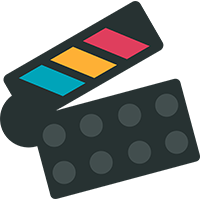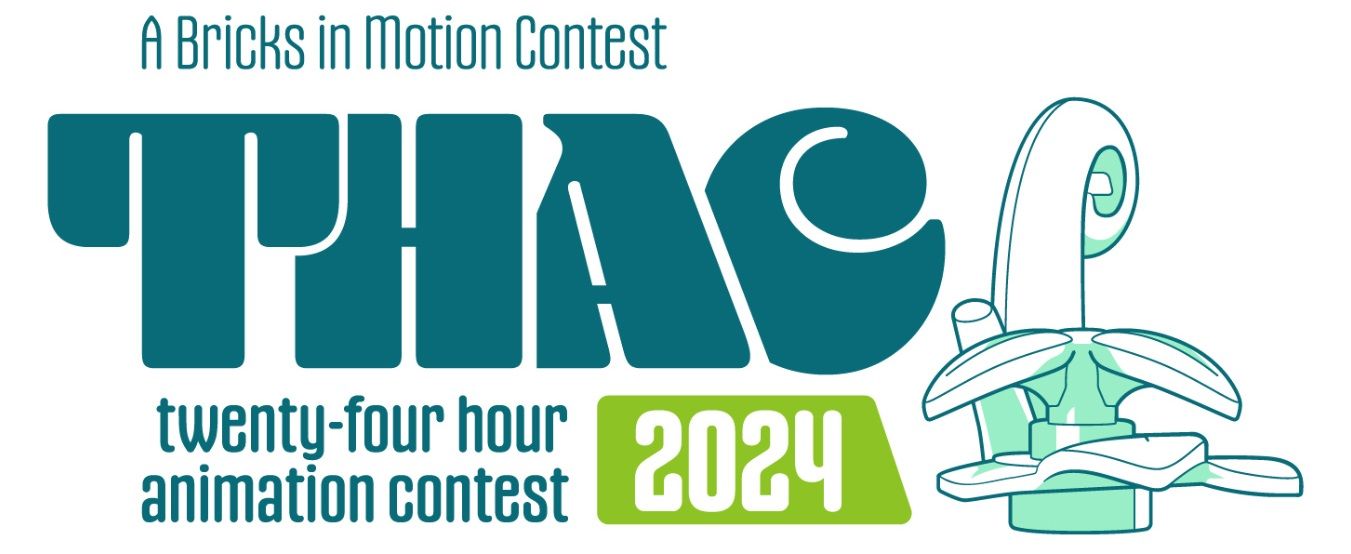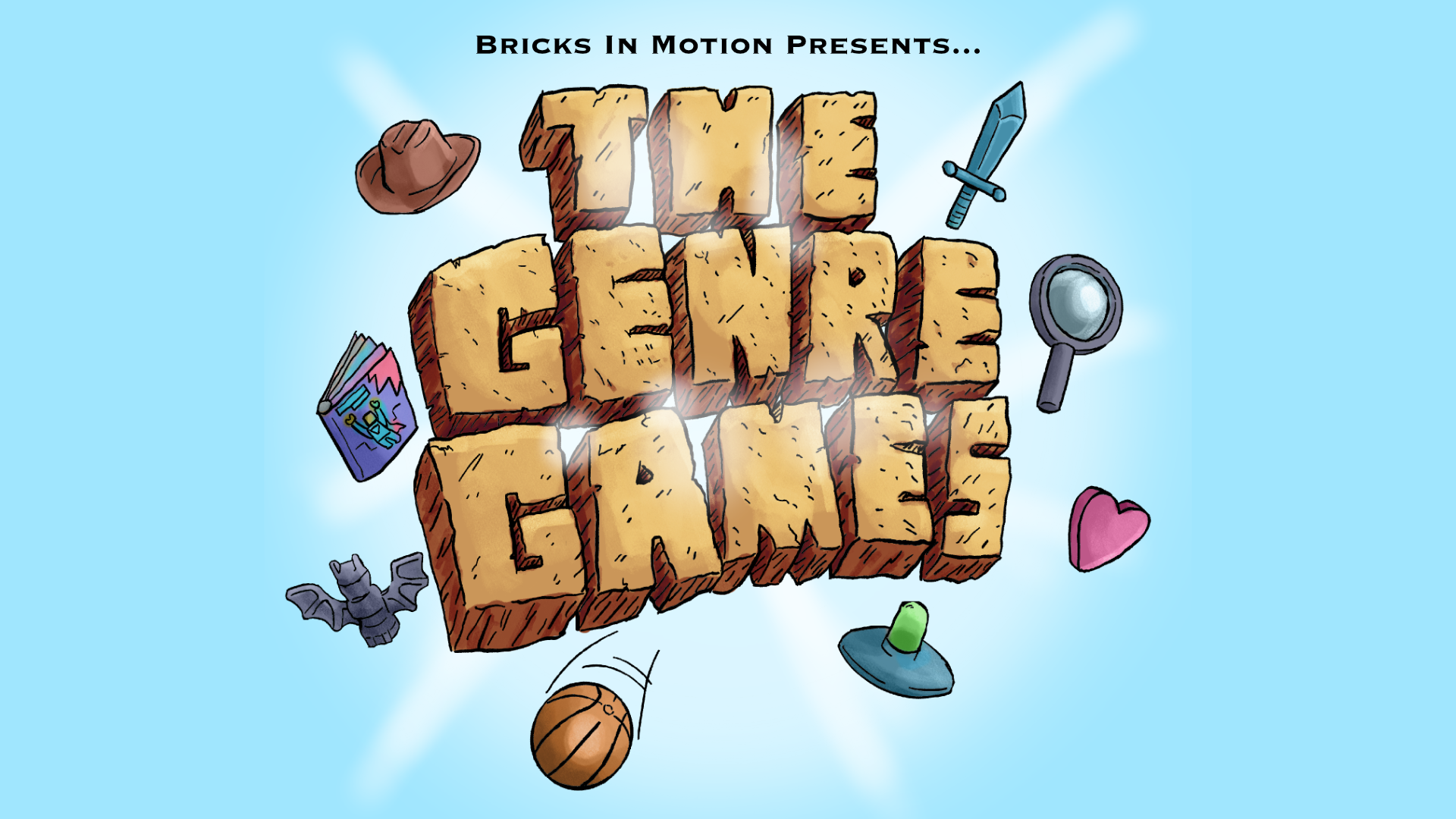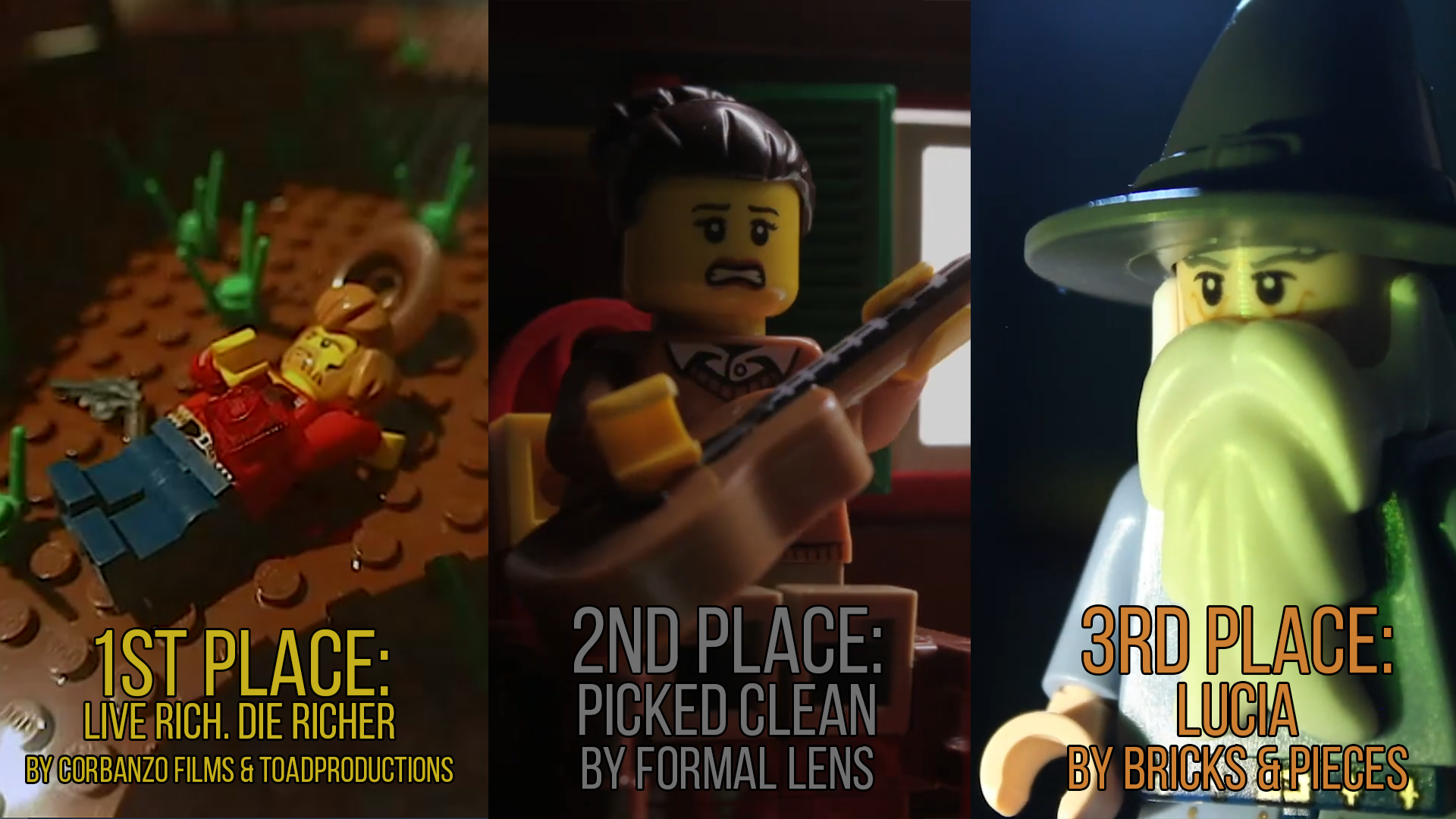I'm posting this by request. I don't think there's anything special about my animation techniques, but I
will explain all my ideas, because Bricks In Motion is all about helping each other out, and if anything anyone
written here does helps somebody out, it's worth it.
----------------------------
EFFICIENT DIALOGUE ANIMATION
----------------------------
------
SET UP
------
I animate on my wife's dresser drawer with the 100-watt lamp to the left of theset, and a 75 watt desk lamp shining
down, with its base to the left of the camera. I turn the camera's flash OFF and have long ago set the white
balance using the back of the white paper from my first script as the test card.
Outdoor scenes in episode 2 are filmed against a bluish wall in the children's room, the only non-Lego I allow to be
visible.
My camera brace is on a 6x14 plate. The plate rests on 1x1 round plates. I put additional plates under the stress
points (such as below the shutter) as well as all 4 corners.
I don't secure the set with masking tape. Perhaps I should. I mark the relative positions of the lights with
Lego bricks that protrude from the set borders and touch the edge of the lamp bases.
I have 2 batteries for my camera. I try to remember to change batteries before a new session.
I keep all the characters, and their favorite accessories, in a single place.
Now here are my animation techniques:
--------------------
BASIC DIALOGUE CYCLE
--------------------
With my series, there are a lot of mundane scenes. By mundane, I don't mean boring (I hope). I just mean that the characters often talk without much action. So I set up animation cycles of each character talking.
My first frame has all the characters in what I call, "First Position". I recommend this for anyone doing a series
that is dialogue-heavy. For my first positions, all characters are looking straight ahead, their legs poised
straight up so the bottom edges of the torsos are parallel with the baseplate, upper arms parallel with the vertical
lines of the torso when viewed from the side, and hands completely vertical or horizontal. I think this makes the
best first position because it's easy to memorize. You may like something different better. It's all to your
preference.
One character at a time, I will make each character talk. First, each character will raise one arm 90 degrees, so
the upper arm is parallel with the baseplate. This takes about 8 to 10 frames of animation, moving the arm up
slightly with each frame. I will call "First position" frame 0. on frames 2 through 4, I lean the character
backward an infinitesimal amount. This helps the character use the real-life momentum required to raise his arm. I
reverse the process on frames 6 through 8, so that the character is standing erect exactly as in frame 0. By frame
8, the arm is raised 90 degrees. I mark this as a keyframe. Frame 9 is exactly like frame 8, but with the arm
raised slightly past 90 degrees. Frame 10 is exactly like frame 8, with the arm back into 90 degree position. This
is an age old technique technique I learned about from my days with hand-drawn animation, and makes people look more organic. Frames 9 and 10 make the character's arm "snap back" into place after going a bit past the destination position, rather coming to a mechanical, sudden stop. When animating robots, you may want to omit this. You can see this in any classic-styled cartoon from Bosco to The (new) Looney Toons Show.
In broad movements such as this, for frames in mid-movement (frames 4, 5, 6 for instance), I move the arm the
greatest amount per frame, and make the most subtle movements nearest the keyframes. Pritchard Studios and others
call this "easing in" and "easing out", depending if occuring at the beginning or ending of the movement. Again, it
eliminates the mechanical feel to motion.
All my frames are numbered. Since frame 8 and 10 are two photos of identical positions, if I have a lighting
variance or jumpiness in that frame, I will delete the problem frame, and make a duplicate of the better frame,
naming it with the deleted frame's number.
To minimize this issue, about 2/3 into episode 2, I began taking multiple photos of all keyframes for the same
reason.
The above motion, which I label deftly as, "raise arm", indicates that the character has begun to speak. I call
frame 10, a keyframe, "SECOND POSITION". As far as the speaking character is concerned, this is the most important
frame. From this frame, I have the character make various simple movments, all of which return to second position.
An example of a sequence of motions:
Second position
Move hand 90 degrees (6 frames)
Return to second position (1 frame)
Move head right (5 or 6 frames)
return to second position (1 frame)
Move head left (5 or 6 frames)
Return to second position (1 frame)
Move arm up (4 frames)
Return to second position (1 frame)
Move other arm up slightly (5 frames)
Return to Second Position (1 frame)
Notice that I put the figure back to second position from each new keyframe in 1 frame. I just animate the first
half of a motion cycle, and then animate the frames in reverse order to complete the cycle. This conserves
animation time nearly by half. With 40 frames or less, you can animate a character talking for 10 seconds or more,
and reuse the animation when the character speaks again!
Let's look more closely at the hand motion. I use six frames from second position to the hand turn. With second
position designated as "Frame 10", since that's the frame number from the arm movement, the frame numbers rotating
the hand 90 degrees are 11 through 16, with 16 as the keyframe with the hand rotated 90 degrees. Frame 17 is
another keyframe, with the hand returned to second position.
when putting the animation together, when I rotate the hand, I put the frames in this order: 10, 11, 12, 13, 14, 15,
16. When I rotate back, I use this order: 16, 15, 14, 13, 12, 11, 17. (Remember that Frames 10 and 17 are the same
positions, and may be used interchangably.)
When the character rotates the hand 90 degrees (restating: from keyframe 10 to keyframe 16), Frames 12, 13, and 14 are moved 1/4, 1/2, and 3/4 of the way to the rotated position. Frame 11 is only slightly moved from frame 10, and frame 15 is almost all the way into keyframe position. This achieves the "easing-in" & "easing-out" effect and
looks beautiful.
When a character is done talking, he returns to first position by lowering his arm. I follow the same technique for
raising an arm when the character begins to talk, with the following changes:
- In the middle frames, the body moves forward instead of backward, to help "push" the arm down.
- After the arm is down, I move the arm past the return point, then back to first position.
Now a have a cycle, from beginning to end, where the character can speak, using a minimal number of photos, but
without sacrificing quality. Since all the secondary movements begin and end at the same point, you can arrange
them in any order. You can also make the character move only part way and return to second position.
Now this can be done for each of the other characters, and you can animate and entire dialouge sequence in 100 to
200 frames!
------------------
ADDITIONAL DETAILS
------------------
To make a character's vocabulary of motions more diverse, I may add additional motions to the sequence, always
returning to second position. For instance, a character seated in a swivel chair can have an arc movement added.
Be sure to remember to animate slightly past the keyframe position and then "snap back".
Another way to diversify the movement repitoire is to make additional combined movements; for instance, move the
head and hand together. You can also make tertiary movements. For instance, in addition to having a sequence for
moving the hand and turning the head, make a sequence for moving the hand, then one for moving the head. From the keyframe where the head is turned, we can turn the hand again, turn it back, then return the head to second
position. Now you can animate just the head turning, or turning the hand with the head turned, depending on whether or not you insert the tertiary motion.
Characters are not supposed to be in constant motion while speaking. It's best to restrict the motions to accented
syllables or strong stress patterns. Keeping the images too static should also be avoided. In my own series, my
general rule (which can be broken) is to have no more than 3/4 of a second idle. When moving, it's most effective
to start the movement 2 to 4 frames before the accented syllable.
In Holding Our Own, Melissa has long, flowing hair. When Melissa turns her head, her hair is not kept in sync.
Let's say that Melissa needs five frames to turn her head, with root position frame 0. When I animate frame 1, I
move her head slightly to the right, but move her hair back into root position, facing forward. Now Melissa's head
is one frame ahead of her hair. For frames 2 through 5, I keep her hair one frame behind, always needing to catch
up. So, when her head is in position at frame 5, Melissa's hair still requires one more frame to line back up with
her head. In frame 6, then, I move ONLY her hair into position. Then in frame 7, I move the hair again so that
it's slightly PAST the position it should be in. In frame 8, I snap the hair back. This means that Melissa's hair
has a delayed start by 1 frame, and takes 3 frames to settle after the head has stopped moving. This kind of
movement, where other body parts are dragged behind and take longer to catch up is called DELAYED SECONDARY
REACTION. This is a staple of traditional animation. Watch a dog's ears in a classic cartoon when he moves his
head to see it in action. Much of the illusion of realistic movement by anthromorphized animals is due to delayed
secondary reactions.
When a character is making a broad movement, it's best to animate the character moving in reverse, as he builds
potential energy in anticipation of the movement. I don't use this technique often except in very large motions,
like before the characters jump on and off the couch. CASE STUDY: Red Hot Riding Hood (MGM, directed by Tex Avery). While Red is dancing, watch the wolf's reactions. Before his head sticks out and his eyes become comicly large,
for instance, he recoils back, building the energy to be able to do something this crazy. CASE STUDY (Brickfilm)
"The Table Flipper". (do a Bricks in motion films search). The announcer uses it before asking the viewer a
question.
----------------------------
THE SPEAKER IS BEING WATCHED
----------------------------
When the character speaks, the others react by turning their heads toward him/her. When the character begins to
speak, it takes the others a moment to react. When the character goes from first to second position, I wait three
or four frames before the other characters move their heads in reaction. It may or may not take a few extra frames
after the speaker reaches second position until their heads are in place. I don't always make the onlooking
characters begin their head turns at once. This way, they don't appear synchronized.
--------------------
ADDITIONAL ANIMATION
--------------------
If a man fires a gun (or a woman... I think I ofended Angela and Melissa in a single clause!), there will be recoil.
Even a controlled shooter will have a reverse reaction to the bullet's powerful movement. It's Newton's Third Law.
Laser guns fire light, which doesn't have the mass to cause this reaction.
In segment 3 of Holding Our Own episode 2, Melissa and some friends are gathered in front of Dwight D. Eisenhower
High School, where a flag is blowing. Since the flag is constantly in motion, additional frames are required to
animate flag movement.
I choose a root position for my flag (or other moving object, like the water fountain in segment 1). For the flag,
root position is parallel to the school. With all the characters in first position, I made a flutter cycle that
begins and ends in root position, so it can be cycled endlessly if the characters stood like statues.
I begin every character movement with the flag in root position. I move the flag slightly during each frame of
character movement. I always end each character movement with the flag one frame away from root position. If the
character has stopped moving and additional frames are required to get the flag one frame from root position, I add
extra frames, moving only the flag.
In addition to all this, I create an "in-between" flag motion cycle for every keyframe that the character is in
position, so that the flag can continue to move during the periods when the character is static while speaking.
Again, these cycles begin with the flag in root position and end one frame away from root position. Since the flag
fluttering is due to the wind, I make each cycle slightly different for a irregular, more natural feel.
Since all movements (and non-movements) contain one full flag cycle, speaking movements be arranged in any order and
still move smoothly, without jerkiness on the flag's part. You can also get away with longer idle periods for the
characters while they speak, since the flag motion keeps the viewer's eye busy.
The only thing to be mindful of is to complete a cycle before moving the character. If you need to cut a flag cycle
short to move the character sooner, just go a few frames into the cycle, and then reverse back to root position.
Also in the school scene, Melissa's BFF Chay Tangemann is introduced. In the bio I wrote for the character, she
follows fashion & glamour trends, but she's in episode 2 only to support the main cast, rather to be developed. To
give the viewer some insight into her character, She is introduced applying lipstick. The same principles for flag
movement are used here.
---------------------------
ANIMATION CYCLE FILE NAMING
---------------------------
My camera, and I think many others, auto-name the files DSC0XXXX.JPG arbitrarily. This is unhelpful when you have
several thousand frames of animation. After deleting unusable frames, I rename the files with a scene or cut
number, and arrange the files, but also add short codes to keyframes and other significant frames. Here's an
example of a basic animation cycle for Brent, each with a .jpg extension:
39d-001-K
39d-002 arm up
39d-003
39d-004
39d-005
39d-006
39d-007
39d-008-K
39d-009 DSR
39d-010-K
39d-011 Turn hand
39d-012
39d-013
39d-014
39d-015
39d-016-K
39d-017-K (=10)
39d-018 Turn head
39d-019
39d-020
39d-021
39d-022-K
39d-023-K (=10)
39d-024 arm high
39d-025
39d-026
39d-027-K
39d-028-K (=10)
39d-029 arm down
39d-030
39d-031
39d-032
39d-033
39d-034
39d-035
39d-036-K (=1)
39d-037 DSR
39d-038-K (=1)
I begin my sequences with frame 1, not zero, as used in demonstrations above.
The letter K denotes a keyframe. Keyframes 1 and 38 (and 36) have the character in first position. Keyframe 10
(and Eight) are second position. You'll see that many keyframes have (=10). This means that all the photos have the character in the same position as frame 10. If there are tertiary motions, other (=) numbers would indicate a frame that is identical to another. The first frame of any movement is briefly described. When animating in the video editor (I use Vegas Studio Platinum), I can jump from frame 10 or any (=10) frame to any frame describing movement, continuing until I reach the next keyframe (k without (=10)). Then I can reverse the movement and skip to any other (=10) keyframe. Keyframes can be extended to make the character pause his movement. In Vegas Studio, the user just pulls the frame in the timeline to the next point of motion.
The "DSR" frames are frames where the character's motion goes slightly past the keyframe and then "snaps back". DSR stands for DELAYED SECONDARY REACTION. Technically, this is misnamed, but since it's for my own personal use, it's okay.
---------------
SCENE STRUCTURE
---------------
I divide the scenes into a series of cuts, and structure it around the major movements. Here's a structure for the
final scene of Holding Our Own, episode 2. Each scene has either a cycle (like the series of files I wrote above
for Brent's cycle) or beginning and ending positions for characters. Each of the lines below is a folder holding
all the images for each movement or movement cycle.
49a Brent seated
49b Melissa enters
49c Brent Speaks
49d Melissa speaks
49e Brent Speaks (close up)
49f Brent reads constitution
49g Melissa kisses Brent
50a Angela Enters
50b Melissa runs
50c Angela speaks
50d Angela shows Barbie
50e Melissa speaks
50f Angie Speaks
50g Melissa takes Barbie
50h Melissa reads Barbie
50i Melissa puts barbie down
51a Angela speaks
51b Melissa speaks
51c Pan to Brent
51d Brent Speaks
By the way, Repelling Spider has a good YouTube video on how to animate walk cycles. He's a pretty awesome
filmmaker.
Each number (49-51) represents an animation session. I try to at least animate all the characters speaking in a
single session. If this doesn't work, I'll change the camera angle or position, so one can transition back & forth
between cuts without the viewer noticing slight changes in lighting, camera's absolute position, etc.
All the folders are subfolders within folders numbered 49, 50, and 51. I often follow these numbers with scene
descriptions. This kind of organization makes life easier. If there is an extended dialogue between Angela and
Melissa, I can go back and forth between 51a and 51b endlessly, since each speaking cycle begins with all characters
in first position. They can speak endlessly after Angle shows the barbie and before Melissa takes it by going
between 50e and 50f endlessly. Brent and Melissa can speak endlessly by going between 49c and 49d. Other folders involve a change in a character or object's position, and a new set of dialogue cycles is required. I've had
animation cycles involving up to four characters with cycles beginning and ending with everyone in first position.
Folder "49f Brent Reads Constitution" has Brent go from first position to getting out and reading his pocket
Constitution, to putting it back in his pocket and returning to first position. So since Brent begins and ends the
cycle in the same position, he and Melissa may resume talking (49c and 49d) with no new animation required. The
same is true for Melissa's kiss cycle.
----
MORE
----
This comprehensively covers my animation technique. But these aren't all my secrets. I may as well tell you
anything I can think of at this time.
- I keep the script handy and imagine the character speaking the words while animating, and how many frames is
required to speak each line.
- Episode 2 was animated at 15 frames per second. Whenever I desribe a suggested number of frames for an action, it is for 15 FPS animation. For 12 fps, reduce the number of frames for a motion by 20%. For 10 FPS, cut out every third frame. For 24 fps, add a frame for every 2.
- I also use the script to plan the organization of the scene structure.
- I like to use tracking motion. In segment 1 of episode 2, Melissa and Angela are at opposite ends of the room
arguing. A character speaks, the camera pans across the room, the other character speaks, repeat. The camera
panning makes the scene look like a ping pong match. If you look closely, you can even see Brent and Johnny Strange turning their heads back and forth while the "ball goes from one opponent's court to the other's". To track the motion, I just move the camera one stud (or two) at a time. In th final scene, I track the motion a bit when
Melissa enters the room. I moved the camera a half stud! at a time, by moving the camera brace diagonally from one stud to the immediate groove adjacent to that stud, then to the next stud diagonally. This can only be done with
the camera brace on 1x1 round plates, because they can fit in a groove in between four studs.
Scene Structure for a ping pong debate:
Xa character 1 speaks
Xb Pan
Xc Character 2 speaks
To go from character 2 back to character 1, use the pan from folder Xb, with the frames arranged in reverse order.
- All the characters in "Holding Our Own" are ambidexterous; this way I don't have to keep track of which arm to
move, and sometimes, unforseen spatial problems make it impractical for a character to use his "regular" arm.
- The character Hector Bing drives a cool convertible in episode 2. The car was kept static in the shot (except the
wheels that were moved), and the background was moved behind it. The background was made of three 8x16 baseplates filled with trees and flowers. These were arranged end to end. 2/3 of the tree arrangements were visible at a time in the camera shots. When I reached the end of the arrangement, whichever baseplate was pushed off-camera was moved to the other edge, to cycle the background endlessly. You can see a visual represenation of this concept on my tumblr page, http://holding-our-own.tumblr.com I moved the baseplates 3 to 4 studs per frame.
- When a character pivots or turns while walking, I step the same way the character does and examine it, so the
character's motions are based on natural walking.
- Characters talking can become visually uninteresting. I like to make a character who is angry or confused perform
an unscripted "take", or absurd reaction, by raising his head almost off his neck, or if in a moment of craziness,
spin their head 360 degrees, or some other visual surprise. But it's important not to overuse the same gags. What
I labeled he "Lipstick cut" in episode 2, segment 1, where Melissa throws lipstick at Johnny, is unscripted but
unique. Use takes sparingly. They are like spice in your brickfilm's recipe. A little bit accents your film
nicely. Too much ruins it.
----------
CONCLUSION
----------
Well, that's all I can think of for now. So now you know how I animated the ending to the episode. I hope someone
can use this to animate a brickfilm reliant on dialogue-based content efficiently, but without cutting corners. If
you use any of these techniques, let me know. I'd love to take a look at your work!
HOlding Our Own is in the "rapid-fire" comedic style, where comedic lines come one after another. Another
rapid-fire technique is a run-on theatre of the absurd, where characters are talking to each other but seemingly in
their own worlds. There is little literary pause between the characters' speaking lines. I just recently watched a
new brickfilm in this latter genre, "HAM ON SET" by MobDeli. The cinematography, dialogue motion,and writing are
top-notch. This guy's film is brilliant, and I think it would be more appropriate to ask HIM how he animated HIS
scene!
https://vimeo.com/channels/holdingourown http://holding-our-own.tumblr.com"None practice tolerance less frequently than those who most loudly preach it."










